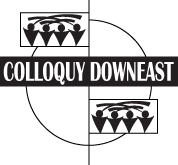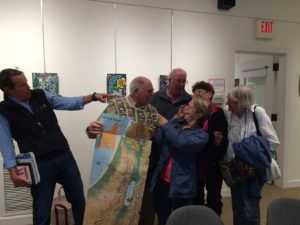Updates and references for digging more deeply
TRUMP ADMINISTRATION
Big step in July 2017: Palestinian blessing for a desalination pipeline from the Red Sea to the Dead Sea. I’ll use this page for more info as it becomes available. As of July 15, here is my initial take:
At least on water, the parties are no longer in the negotiation posture of “nothing is resolved until everything is resolved.” My blog and presentations have emphasized the potential for a water agreement ‘baby step.” This big a project is at least a “toddler step,” though it does not address all the water issues. In this agreement, Israel gets blessing for the pipeline project and significant support from the Palestinians’ Sunni allies. Palestine gets early access to water to fill its existing distribution pipelines. It is significant that bipartisan State Dept alums have endorsed the July 2017 agreement. It was also supported by Ecopeace, (the Tel Aviv/Bethlehem/Amman enviro group with which I am most familiar) which has criticized a Red-Dead pipeline. Earlier, the enviros have mostly opposed the Red-Dead project, arguing brine pollution and excess energy use.
Wastewater is a tough issue, but there are several transboundary wastewater projects between local Palestinian and Israeli entities. The biggest unresolved wastewater problem is the Kidron River drainage downstream from Jerusalem & Bethlehem into the Jordan Valley. But because it is just above the Dead Sea, it would not surprise me if a Kidron project moved forward in response to the Red-Dead deal.As in all water matters, long term management and control of the spigots will be troublesome. Water can be a tool for peace — or one for control, occupation and even war. As of July 2017, the Palestinian & Israelis are using the Red-Dead to kick start the peace process. The devils are in details and administering a water agreement that is simultaneously (1) clear; but also (2) flexible enough to adapt to changing hydrology, technology, economics and politics. Those with experience in water agreements between Indian Tribes and other sovereigns in the western United States may may find similarities in these institutional and legal administrative issues. How can such complex institutions work between “asymmetric sovereigns,” where one party controls the water supply through technology, capital and raw power and the other party has deeper cultural ties to the land and ancient claims?
In March 2017, Trump put everyone on banana peels, both Israeli and Palestinian. This is not an uncommon negotiating tactic. It seems to be working here because the U.S. presence in Israel AND the West Bank is so massive. When the 900-lb gorilla can dominate global narratives with a single arbitrary and capricious tweet, the other parties have to take notice.
KERRY’S HANDOFF TO TRUMP
Samantha Power statement abstaining from UN Vote on Resolution 2334 (December 23, 2016). This is a more concise statement than John Kerry’s speech on six principles, December 28, 2016. See embedded text in article from Haaretz.
In January 2017, George Mitchell published a short history of U.S. efforts toward a two state solution. He speaks at David’s Folly farm in Brooksville on July 10, and may refer to the one chapter in his book, THE NEGOTIATOR which gives a good overview, and a highly edited brief overview of his time as Obama’s delegate on the Two-State effort in 2009-2011 (See pp 325-336) .
TOUR GROUPS:
Palestinian Christian: Footsteps of Jesus; Siraj Center in Beit Sahour
Jewish Peacenick: Mejditours;
Environmental: FoEME EcoTourism (see box at lower right);
BOOKS:
Azlan, ZEALOT: THE LIFE AND TIMES OF JESUS OF NAZARETH (2014). (Well written historical summary by Iranian author).
Carter, PALESTINE, PEACE NOT APARTHEID, (2006) (Former President’s analysis, widely praised by some and widely condemned by Israeli advocates, including the progressive jewish diaspora — see Ameinu paper linked below).
Cohen, THE WORST KEPT SECRET: ISRAEL’S BARGAIN WITH THE BOMB(2010). (Scholarly summary of nuclear proliferation by Israeli expat).
Indyk, INNOCENT ABROAD: AN INTIMATE ACCOUNT OF AMERICAN DIPLIMACY IN THE MIDDLE EAST (2009) (Perpectives on personalities from former US Ambassador to Israel who became negotiator for John Kerry).
Miller, THE TOO MUCH PROMISED LAND(2008) (Insider’s summary of Kissinger, Carter, Baker, Clinton and Bush II negotiation strategies).
Ross, THE MISSING PEACE: THE INSIDE STORY OF THE FIGHT FOR MIDDLE EAST PEACE (2004) (US envoy to the Middle East, 1988-2000).
Sacks, NOT IN GOD’S NAME: CONFRONTING RELIGIOUS VIOLENCE (2015) (Rabbi employs biblical text to explore “the better angels of our nature”).
ARTICLES
Thrall, “Obama & Palestine: The Last Chance,” New York Review of Books,” September 10, 2016
NYT on distinction between settlements and outposts, August 31, 2016
The potential for significant change in Palestinian leadership is described in this November 3, 2016 NYT article. Muhammed Dahlan and Marwan Barghouti appear to be crucial figures in the post-Abbas period.
November post-election update by Vox, summarizing surmises about the presidential transition and Obama action or inaction in the U.N.
WEB PAGES
Wikipedia sites on Israeli-Palestinian Peace Process; Taglit Birthright Israel; Boycott, Divestment and Sanctions; Israel-US military relations; US security assistance to PA; Palestinian refugees & UNRWA and ……
Sly, “Distillation” from Water Pathways: Exploring Palestinian-Israeli Water Issues on the West Bank of the Jordan River, (2015).
Israeli Ambassador Ron Dermer’s message to (theoretically) incoming Clinton Administration.
October 16, 2016 MPBN interview with George Mitchell, Clinton’s representatives in deepest US-brokered Palestinian0 Israeli talks during Obama administration. This is discussed from minute 23 to minute 37 in the podcast. Mitchell plans to publish a book on the subject in the next two months.
Fascinating discussion about whether and how to teach Israel-Palestine issues in the University. The AAUP is widely read and generally respected magazine for U.S. faculties.

